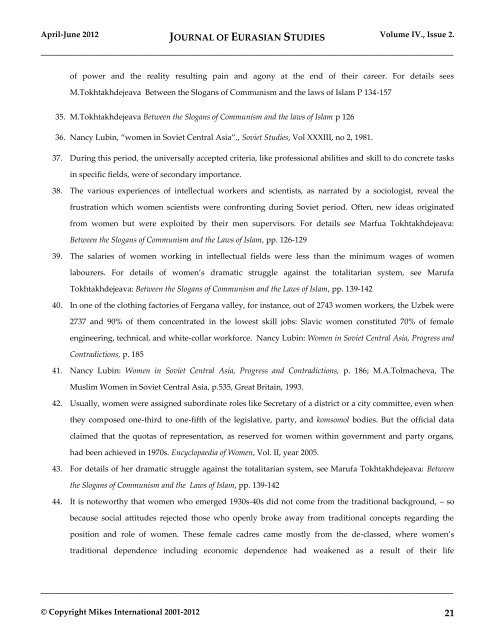Create successful ePaper yourself
Turn your PDF publications into a flip-book with our unique Google optimized e-Paper software.
April-June 2012 JOURNAL OF EURASIAN STUDIES Volume IV., Issue 2.<br />
_____________________________________________________________________________________<br />
<strong>of</strong> power and the reality resulting pain and agony at the end <strong>of</strong> their career. For details sees<br />
M.Tokhtakhdejeava Between the Slogans <strong>of</strong> Communism and the laws <strong>of</strong> Islam P 134-157<br />
35. M.Tokhtakhdejeava Between the Slogans <strong>of</strong> Communism and the laws <strong>of</strong> Islam p 126<br />
36. Nancy Lubin, “women in Soviet Central Asia”., Soviet <strong>Studies</strong>, Vol XXXIII, no 2, 1981.<br />
37. During this period, the universally accepted criteria, like pr<strong>of</strong>essional abilities and skill to do concrete tasks<br />
in specific fields, were <strong>of</strong> secondary importance.<br />
38. The various experiences <strong>of</strong> intellectual workers and scientists, as narrated by a sociologist, reveal the<br />
frustration which women scientists were confronting during Soviet period. Often, new ideas originated<br />
from women but were exploited by their men supervisors. For details see Marfua Tokhtakhdejeava:<br />
Between the Slogans <strong>of</strong> Communism and the Laws <strong>of</strong> Islam, pp. 126-129<br />
39. The salaries <strong>of</strong> women working in intellectual fields were less than the minimum wages <strong>of</strong> women<br />
labourers. For details <strong>of</strong> women’s dramatic struggle against the totalitarian system, see Marufa<br />
Tokhtakhdejeava: Between the Slogans <strong>of</strong> Communism and the Laws <strong>of</strong> Islam, pp. 139-142<br />
40. In one <strong>of</strong> the clothing factories <strong>of</strong> Fergana valley, for instance, out <strong>of</strong> 2743 women workers, the Uzbek were<br />
2737 and 90% <strong>of</strong> them concentrated in the lowest skill jobs: Slavic women constituted 70% <strong>of</strong> female<br />
engineering, technical, and white-collar workforce. Nancy Lubin: Women in Soviet Central Asia, Progress and<br />
Contradictions, p. 185<br />
41. Nancy Lubin: Women in Soviet Central Asia, Progress and Contradictions, p. 186; M.A.Tolmacheva, The<br />
Muslim Women in Soviet Central Asia, p.535, Great Britain, 1993.<br />
42. Usually, women were assigned subordinate roles like Secretary <strong>of</strong> a district or a city committee, even when<br />
they composed one-third to one-fifth <strong>of</strong> the legislative, party, and komsomol bodies. But the <strong>of</strong>ficial data<br />
claimed that the quotas <strong>of</strong> representation, as reserved for women within government and party organs,<br />
had been achieved in 1970s. Encyclopaedia <strong>of</strong> Women, Vol. II, year 2005.<br />
43. For details <strong>of</strong> her dramatic struggle against the totalitarian system, see Marufa Tokhtakhdejeava: Between<br />
the Slogans <strong>of</strong> Communism and the Laws <strong>of</strong> Islam, pp. 139-142<br />
44. It is noteworthy that women who emerged 1930s-40s did not come from the traditional background, – so<br />
because social attitudes rejected those who openly broke away from traditional concepts regarding the<br />
position and role <strong>of</strong> women. These female cadres came mostly from the de-classed, where women’s<br />
traditional dependence including economic dependence had weakened as a result <strong>of</strong> their life<br />
_____________________________________________________________________________________<br />
© Copyright Mikes International 2001-2012 21
















